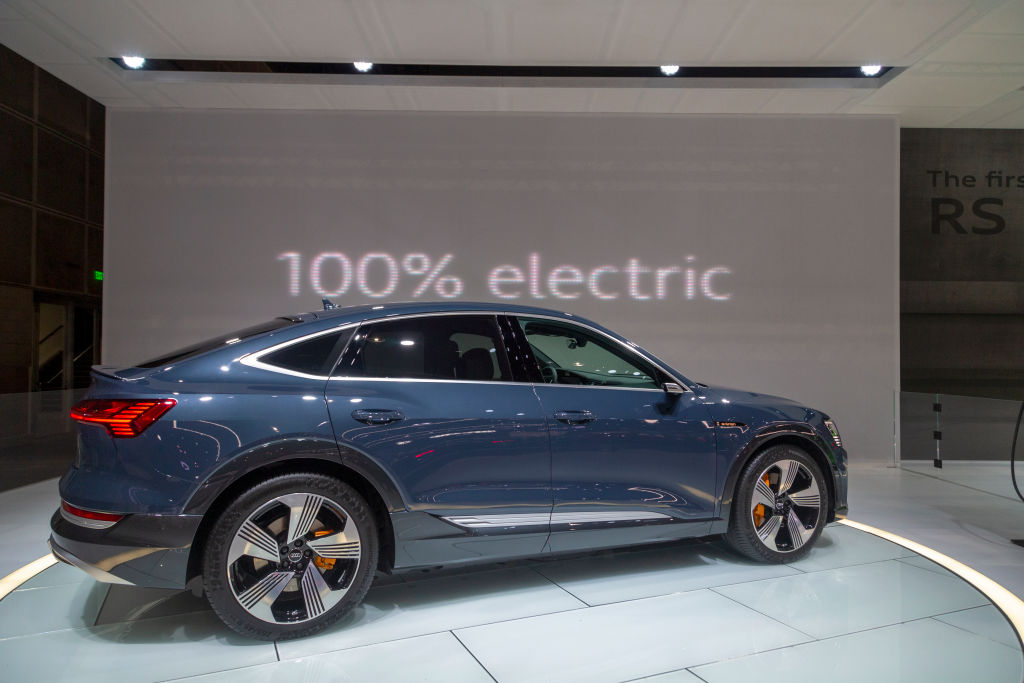| |
| Several recent reports say that President Biden’s new EV mandates will likely amount to a sizable wealth transfer from the poor to the rich, and from rural red regions to urban, blue, Democrat-voting districts. |
| On March 20, the Environmental Protection Agency (EPA) finalized its tailpipe emissions rules for the auto industry starting in 2027. These rules are the strictest in history and will effectively force carmakers to have one-third of new car sales be plug-in electric vehicles (EVs) by 2027 and more than two-thirds be EVs by 2032. |
 The Audi E-Tron Sportback electric car is shown at AutoMobility LA on Nov. 21, 2019 in Los Angeles, California. (David McNew/Getty Images) The Audi E-Tron Sportback electric car is shown at AutoMobility LA on Nov. 21, 2019 in Los Angeles, California. (David McNew/Getty Images) |
| Climate activists cheered the move, with the Environmental Defense Fund calling it “a day to celebrate American achievement.” |
| But critics say that these measures will be costly, especially for less wealthy Americans who don’t want, can’t use, or can’t afford EVs. |
| “This isn’t industrial policy,” Robert Bryce, author and energy analyst, told The Epoch Times. “In reality, it’s a type of class warfare that will prevent low- and middle-income consumers from being able to afford new cars.” |
| According to an October 2023 report by the Texas Public Policy Foundation, as much as $48,000 of the cost of the average EV sold in the United States is paid, not by the owner, but in the form of “socialized costs” that are spread out among taxpayers and electricity consumers over a 10-year period. |
| These socialized costs come in the form of taxes, subsidies, fuel economy credits paid by gas carmakers to EV manufacturers, and higher electricity bills as consumers absorb the capital costs to expand the power grid and build charging stations. |
| The report states that “the average model year 2021 EV would cost $48,698 more to own over a 10-year period without $22 billion in government favors given to EV manufacturers and owners.” |
| If carmakers go along with Biden’s plan to shift their fleets to EVs, the cost of remaining gas-fired cars and trucks will likely escalate as demand dwarfs supply. |
| “The EPA mandate is aimed at accommodating a very narrow segment of the auto-buying public: wealthy, white Democrats who live in a handful of liberal communities,” Mr. Bryce said. |
| In a February analysis, Mr. Bryce reported that 57 percent of EV buyers earn more than $100,000 per year, 75 percent are male, and 87 percent are white. In addition, EV buyers are overwhelmingly Democrats, with 71 percent of Republicans stating in a Gallup poll that they would not consider owning an electric vehicle. |
| A 2023 University of California Energy Institute report found “a strong and enduring correlation between political ideology and U.S. EV adoption.” Looking at county-level data on new vehicle registrations between 2012 and 2022, the report stated that 50 percent of all new EVs were sold into the top 10 percent of most-Democrat counties, with 70 percent going to the top 25 percent most-Democrat counties, and 90 percent going to the top 50 percent most-Democrat counties. |
| Twenty counties bought 40 percent of all EVs sold in this period, the report states, and “most of these counties are urban, high-income, and in Democratic states.” |
| According to the U.S. Department of Energy, California had 903,600 registered EVs, or 37 percent of all EVs owned nationwide, as of year-end 2022. The next-largest states for EV owners were Texas, Florida, and Washington state, with 149,000, 168,000, and 104,100 EVs respectively, followed by New Jersey, New York, Georgia, Colorado, Illinois, Massachusetts, Virginia, Maryland, and Pennsylvania. |
| The common denominator among these states is the presence of large cities and suburbs, as opposed to rural states like Wyoming and North Dakota, where 800 and 600 EV owners reside, respectively. |
| According to a report by the Committee to Unleash Prosperity (CTUP), “if you count all the EVs in North Dakota, South Dakota, Wyoming, Mississippi, West Virginia, Alabama, Montana, and Idaho, they account for less than one percent of the total U.S. sales.” |
| “Ironically, Joe Biden is the worst thing that ever happened to this industry,” CTUP states. “EVs have become ‘Biden cars.’” |
| Politics aside, there are practical reasons why people are unwilling to spend thousands of dollars more on what, for them, is an inferior vehicle. |
| Rasmussen Reports, which polled Americans’ views on the Biden EV mandate, stated that “EVs may be practical to zip about in the mild weather of the Pacific Coast and over the short distances of the Northeast—Biden territory in 2020. But EV batteries run out of charge over long distances, when it’s freezing outside, or when you’ve got your air conditioning on—all common experiences in the South, Midwest and Rocky Mountain states, which Trump carried in 2016 and 2020.” |
| A recent Rasmussen poll of voters found that only 14 percent were strongly in favor of regulations to phase out gas-powered cars and trucks, while nearly 60 percent were against. Opinions split along party lines, with 53 of Democrats in favor of the EPA regulations and 76 percent of Republicans against, with 59 percent of independents also opposing. The strongest support for EV mandates came from people earning more than $150,000 a year. |
| To dig deeper into the subject, read the following original reporting by our journalists: | |
| |
| |
| |
Thank you for being a subscriber
If you enjoy what you’re reading, please consider forwarding this email to someone who might find it informative. Your Feedback
We'd love to hear from you. You can email us at topstory@epochtimes.nyc We may feature an exerpt of your response in the next newsletter.
| | |